MARCPO 2010: The Making of a Great Conference
This page may contain links to Amazon.com or other sites from which I may receive commission on purchases you make after clicking on such links. Read my full Disclosure Policy
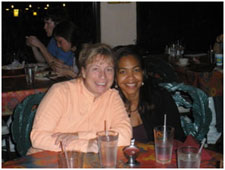
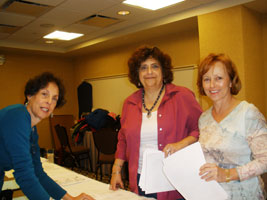
MARPCO 2010 volunteers: Lynn Meltzer, Alisa Levy, and Susan Unger
Every year for over a decade, the Metro Washington, DC Area Chapter of NAPO has hosted MARCPO, the Mid-Atlantic Regional Conference for Professional Organizers. For the benefit of others who might be interested in holding a similar event, I asked Deb Lee, Marketing Chair of MARCPO 2010, what goes on behind the scenes, and here’s what she told me.

If you’re like me, you like attending conferences. If you’re like me, you expect the ones you attend will have great food, amazing speakers, and be in a comfortable location. Not only will the content be fabulous, but you’ll also get to see old friends and connect with new ones.
If you’re like me, when the conference you’re attending is one that you’re also helping to organize, you absolutely want it to be great. And, if you’re really are like me, then you know what it’s like to work with an amazingly tireless group of people to put on an equally amazing conference. Working behind the scenes on NAPO-WDC‘s 12th Annual Mid-Atlantic Regional Conference for Professional Organizers (MARCPO 2010 – Purpose, Passion, Profit) was fun, exhausting, exhilarating, and any other word you can think of when you’ve been immersed in it for twelve months!
Though it was the third year in a row that I’ve worked behind the scenes, I still learned a thing or two about what it’s like to coordinate the many arms of a conference. If your association or group is thinking about putting on a great conference, you’ll need to do a lot, and you must have the “3 P’s.”
People

Judy Parkins
Before you have a plan, you need people. Sound counterintuitive? It isn’t really. You can plan till the cows come home, but if there’s no one around to execute said plan, well, you don’t have much, do you? Besides, when you have people, they can help you create a plan so fabulous that everyone will look like rock stars. Sometimes, your people get clever and get their own people (think sub-committees). When everyone steps up to the plate and takes care of the things they’re tasked with, you’re almost guaranteed that you’ll put on a 5-star event.
“Say what you’ll do – then follow through.”
–Judy Parkins, MARCPO 2010 Chair
Care to guess how many people worked on MARCPO 2010? There was the Conference Chairperson, Judy Parkins, who pulled everyone together. She had four committee chairs (Speakers, Expo, Marketing, & Program), and each of them had their own committee members. There were also volunteers who manned the registration desk, handled the AV, fixed speaker slides, and made sure we had banners and signs. Did I mention that we had a Community Partner liaison who handled the donations we received? How about the folks who eye-balled our docs and website content to make sure there were no typos? …hmmm…think I might be forgetting a few people…
All in all, there were 30+ people involved behind the scenes. So, you see, people really come first.
“Another important element of creating a successful conference is a shared vision. All of the people involved knew that we could produce a high-quality, classy, professional event with a very strong educational component. We were all working hard to reach that same goal.”
–Julie Gray, MARCPO 2010 Expo Chair
Purpose
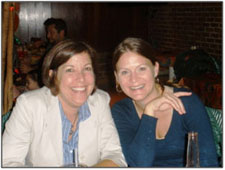
You probably thought that the second “P” would be plan. No, not yet. You need a reason or purpose for pulling all these fabulous people together.
So, what’s the point? Is there a vision for the conference? What do you hope attendees will learn and experience? Solidifying the purpose will drive the direction and feel of your event. When carefully crafted – and if your people are all on the same page – the memory of your conference will be forever imprinted in the minds of everyone in attendance. Yes, they will remember the content, but they will also remember how they felt, the connections they made, and they will remember to come back next year.
The MARCPO 2010 team wanted to create a conference that was positive, energizing, and filled with diverse programming that would appeal to both new and experienced organizers. We wanted attendees to walk away with an excitement level so high that when coupled with relevant information, they would be better equipped to serve their clients.
“Planning early allowed us lots of time to work a little at a time.”
–Cris Sgrott-Wheedleton, Program Chair
Plan
This is where the people, purpose, and plan all come together. It’s time to get into the nooks and crannies and figure out who’s going to do what and when. This means creating a timeline with specific dates of completion. Did you remember the Save the Date cards? What about the conference logo? Who will contact the graphic designer? Did the Tweet Up stickers get printed? What time will the Pre-Conference session start?
At the risk of making your head explode, here are other things to consider (not a comprehensive list, nor in any particular order, but a good starting point):
- Budget, Contract
- Social Media, Press Releases, Website Updates, Media Coverage
- Venue (rooms, food, parking, point person)
- Audio/Visual, Photographer
- Sponsors, Vendors, Exhibitors, Door Prizes
- Signs, Banners, Easels, Stickers, Ribbons, Buttons
- Speakers (gifts, accommodations)
- Registration, Name Tags, Conference Bags, Binders
- Length of Event & Logistics
- Thank You Notes/Cards
- Conference Debrief (lessons learned)
- Next Conference
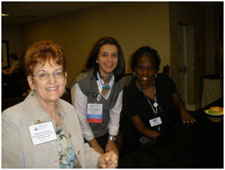
Cris Sgrott-Wheedleton, Program Chair & conference attendees
As you can see, there are a myriad of things to think about and do. Map out the plan, assign the people, and give them deadlines.
And, don’t forget to check in on a regular basis. The MARCPO 2010 crew had a standing call once a month from March to July which increased to once every three weeks and then once a week as the conference drew near. Having frequent calls kept everyone accountable, allowed for reassignments, and gave everyone a chance to ask questions. Was it easy to carve out time for the high frequency of calls? No…but, ultimately, it was well worth it.
The Ancillary “P”
Once you’ve taken care of the 3 P’s, you’ll be well prepared for the big day. But, wait! There is one more thing to think about. You need a back-up plan. What happens if things don’t go as planned, like say a speaker doesn’t show up? Two MARCPO speakers arrived later than we anticipated, and in the moments before they actually got there, we decided that if they were not present within five minutes, we’d assemble an expert panel. The good news is that both speakers arrived on time and we didn’t need our back up plan. But, it was great knowing we had a “Plan B” to fall back on.

The Final Word
Planning well in advance with a committed team focused on the same goals is essential. Just remember that it’s your conference, too. Attend sessions, connect with friends, meet new ones, and eat.
If you’re like me, you’ll remember to have fun!
“This year’s conference was filled with ideas that challenged me to move my business ahead. I most enjoyed meeting new people and seeing friends.”
–Janet Schiesl, Speaker Chair


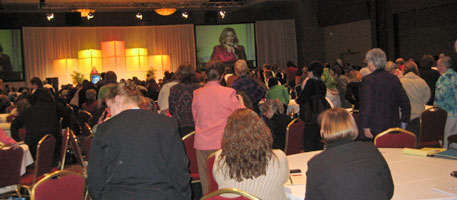

Congratulations on your successful conference. With all that clearly went into its planning, its success is not surprising!
Thanks so much for the kind comments, Kathy. We couldn’t have done it without all the awesome people who volunteered to help! =)
Working on the MARCPO conference is a great example that hard work pays off. It was a wonderful day of education, but the greatest benefit I received was to connect or reconnect with my colleagues. We ROCKED!
Thanks to Deb Lee for the great article on The Making of MARCPO 2010. The event was such fun and well worth the effort.
Great article, Deb! You show the reader the behind-the-scene volunteers and walk them through several of the many steps necessary to produce an excellent conference!
Deb, thank you so much for taking the time to share this information! As I go to the POC Conference in Montreal this week, I’ll have a much greater appreciation for the amount of work involved and the number of hours the volunteers put in to pull it off.